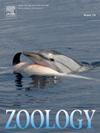Vertical transfer of bacterial symbionts via a placental analogue in the cyclostome bryozoan Patinella verrucaria (Stenolaemata): Ultrastructural and molecular evidence
IF 1.6
3区 生物学
Q2 ZOOLOGY
引用次数: 0
Abstract
Symbiotic associations with prokaryotes are common among marine filter-feeding invertebrates. In the almost exclusively colonial phylum Bryozoa, however, such associations have only been recorded in some species of the order Cheilostomata (class Gymnolaemata). Here we describe for the first time symbiotic bacteria in the colonies, larvae and developing ancestrulae of the bryozoan Patinella verrucaria from the order Cyclostomata (class Stenolaemata) using transmission electron and fluorescent microscopy. Ultrastructural and molecular data suggest the existence of two distinct bacterial species, both from the family Rhodobacteraceae. The presence of bacteria in all three stages of the bryozoan life cycle indicates a vertical transfer of symbionts. Both intracellular and free bacteria were recorded in the colonies, being presumably transported by amoebocytes from autozooids to the colonial incubation chamber. The bacteria are accumulated in the placental analogue and in associated cells surrounding developing embryos and larvae, and are presumably transmitted to the mature ciliated larvae during rupture of the placenta facilitated by the movements of their cilia before and/or during larval release. Thus, the nourishing function of the placenta is complemented by the symbiont transfer, which can be regarded as an example of extension of functions. This is the first example of a placenta providing bacterial infection to the progeny in invertebrates.
细菌共生体在环状苔藓虫中的胎盘类似物垂直转移:超微结构和分子证据
与原核生物的共生关系在海洋滤食性无脊椎动物中很常见。然而,在几乎完全是殖民地的苔藓虫门中,这种关联只在Cheilostomata目(Gymnolaemata纲)的某些物种中有记录。本文首次利用透射电子显微镜和荧光显微镜对环口目(窄口目)苔藓虫疣斑苔藓虫菌落、幼虫和发育始祖中的共生细菌进行了描述。超微结构和分子数据表明存在两种不同的细菌,都来自红杆菌科。在苔藓虫生命周期的所有三个阶段都有细菌的存在,这表明了共生体的垂直转移。在菌落中记录了胞内细菌和游离细菌,可能是由变形虫细胞从自体动物运送到菌落孵育室的。细菌聚集在胎盘类似物和发育中的胚胎和幼虫周围的相关细胞中,并可能在胎盘破裂期间通过其纤毛在幼虫释放前和/或释放期间的运动传播给成熟的纤毛幼虫。因此,胎盘的滋养功能是由共生转移补充的,这可以看作是功能扩展的一个例子。这是在无脊椎动物中胎盘为后代提供细菌感染的第一个例子。
本文章由计算机程序翻译,如有差异,请以英文原文为准。
求助全文
约1分钟内获得全文
求助全文
来源期刊

Zoology
生物-动物学
CiteScore
3.90
自引率
0.00%
发文量
37
审稿时长
70 days
期刊介绍:
Zoology is a journal devoted to experimental and comparative animal science. It presents a common forum for all scientists who take an explicitly organism oriented and integrative approach to the study of animal form, function, development and evolution.
The journal invites papers that take a comparative or experimental approach to behavior and neurobiology, functional morphology, evolution and development, ecological physiology, and cell biology. Due to the increasing realization that animals exist only within a partnership with symbionts, Zoology encourages submissions of papers focused on the analysis of holobionts or metaorganisms as associations of the macroscopic host in synergistic interdependence with numerous microbial and eukaryotic species.
The editors and the editorial board are committed to presenting science at its best. The editorial team is regularly adjusting editorial practice to the ever changing field of animal biology.
 求助内容:
求助内容: 应助结果提醒方式:
应助结果提醒方式:


